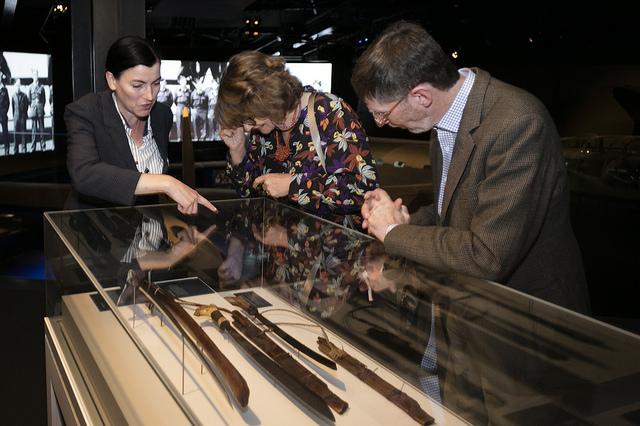Mission: disruption and sabotage
On the evening of Anzac Day, 1986 Rowan Waddy visited Cresswell Chalmers and his family. The two veterans of Z Special Unit had served on clandestine operations involving reconnaissance and sabotage behind enemy lines in the jungles of Borneo. Ten years after the lifting of the official secrecy regarding their work, they had marched under the banner of Z Special Unit and were able to talk about their experiences – although 30 years of enforced secrecy had built a habit of not talking about the war.

Lieutenant Cresswell Chalmers, Services Reconnaissance Department, Z Special Unit, in Sydney meeting his wife and her brother on his first day back in Australia after service in Dutch Borneo during the Second World War. AWM C2629146
That same evening, Chalmers’ daughter, Christine, read her father’s war time diary for the first time. She later discovered a detailed report on an operation behind the lines. These rare records are now part of the Memorial’s collection. They provide a glimpse into Chalmers’ mission and experiences in the remote jungles of Borneo, fighting the Japanese who had invaded Borneo in 1941, and working with the indigenous Dayak people. The objective of the operation called Platypus was to prepare for the Australian-led assault on Borneo in the Balikpapan area of Dutch Borneo. Operatives trained in unarmed combat and jungle survival worked under constant risk of discovery by the Japanese, and depended heavily on support and assistance from the Dayaks.
Chalmers’ diary includes details of his mission to gather intelligence and report on Japanese movements, which also involved training and arming the Dayaks, many of whom had already been conducting guerrilla warfare against the Japanese. Among other incidents, the papers record a terrifying account of Chalmers and his small party being mistaken for Japanese soldiers and strafed relentlessly by two Spitfires. Sergeant Ali Bin Saleh, a pearl diver before the war, is reported as having dived into a crocodile infested river, while Chalmers wrote of hiding behind a “small tree which was hit and splintered”. Chalmers also recorded a detailed account of an action involving his party against over 50 Japanese:
We were virtually without any cover and as we neared a low bushy area I was nearly deafened by the noise of bullets seemingly around my head area – I went to the kneeling position as did all on my right, looking for targets – Bowditch was standing screaming obscenities and firing his Bren in bursts of 5 steadily advancing - we not wanting to look like wimps joined him advancing and firing virtually at gun smoke and an occasional glimpse of a uniform, each firing 2 to 3 magazines and then each throwing 2 grenades into the low cover. The Jap machine gun (JUKI) had gone quiet and I insisted that we break off contact – Wilkie had been hit on the thigh but the bullet had gone through the leg which didn’t bleed for some time. He was eventually evacuated by Catalina to Balikpapan.
This action led to Sergeant Jim Bowditch being awarded the Distinguished Conduct Medal, while Sergeant Stanley Taylor was awarded the Military Medal. Chalmers recorded that he had made the recommendations.
The Matter of Trust exhibition features stories from behind enemy lines in Borneo and displays original artefacts, including a parang – a Dayak sword given as a parting gift to Chalmers from a Dayak chief , James Bowditch’s medal set, and Chalmers’ original diary. The diary, report, and a transcript by Chalmers’ daughter Christine can be viewed on the Memorial’s website.

Cresswell Chalmers’s Parang on display in the Matter of Trust exhibition.